Pantheon Art Story | Location | Opening Hours Tickets | Authorisations
Art Story Story | Porch Rotunda | Cupola | Basilica | Chapels Tombs
The Pantheon Basilica in Rome in Italy
The Pantheon: An Unparalleled and Avant-Garde Monument
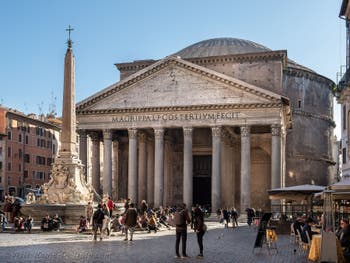
Outside of the Pantheon The Pantheon in Rome remained unsurpassed for centuries in its design and imposing size.
To date, it is the best-preserved monument from Roman times and one of the most famous in the world.
Its architectural avant-garde influenced architects so much during the centuries following its construction that numerous variations have been found worldwide, from the Renaissance period to the present day.
The technique used to build the Pantheon was so innovative that the architecture of its dome inspired Filippo Brunelleschi to design and build the dome of the Basilica of Santa Maria del Fiore, Florence's superb Duomo.
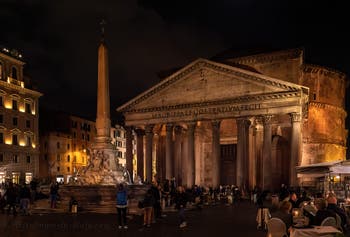
Outside of the Pantheon Michelangelo studied the Pantheon dome in detail before designing the architecture of Saint Peter's Basilica dome in Rome.
Over the centuries, the design of the Pantheon was thus the primary reference in the construction of centrally structured buildings.
A big tip of the hat to the Roman architects who designed it... two thousand years ago!
Figures from the Pantheon
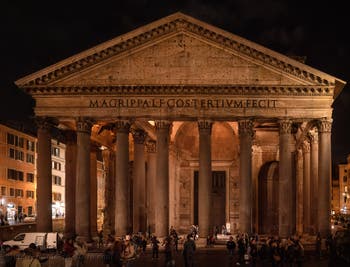
Outside of the Pantheon The Pantheon was built in 10 years: from 118 to 128 AD
The porch of the Pantheon is 34 m wide and 15.5 m deep.
It is framed by 16 monolithic granite columns, 12.5 meters high and 1.5 meters in diameter.
The rotunda's interior measures 43.3 meters in diameter and 43.3 meters high up to the dome's oculus, which is nine meters in diameter.
The walls of the rotunda are six meters thick.
History of the Pantheon in Rome and its Construction
The Pantheon we can admire today is the third temple built on this site.The First Pantheon
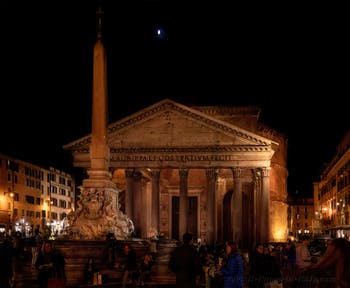
Outside of the Pantheon Between 27 and 25 BC, the first temple was built on the site of the current Pantheon by Marcus Agrippa, a temple dedicated to his father-in-law, the deified emperor Augustus.
This first temple, rectangular in shape, was later dedicated to all the protective gods of the line of Augustus.
It, therefore, received the Greek name “Pantheon”, which means Temple of All Gods.
Unfortunately, this first Pantheon was destroyed by fire in 80 AD, probably because it only partially satisfied the gods who were supposed to protect it.
The Second Pantheon
Domitian built a new temple on the same site, destroyed by another fire in the year 110.Building of the Third Pantheon
Eight years after the destruction of the Temple of Domitian, Emperor Hadrian, in turn, decided to build a new Pantheon, the current Pantheon located in the exact location of the two previous temples.The Pantheon: a Dynastic Sanctuary with a Cosmic Purpose
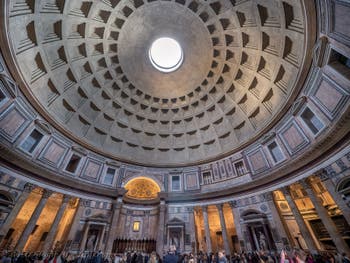
Cupola of the Pantheon This Pantheon, admired for its architectural and artistic qualities, was primarily intended to be a religious building where Romans came to honour their gods and obtain protection.
This majestic dome of the Pantheon, of the Temple of All the Gods, symbolised Paradise because the ancient Romans represented Paradise in the form of a sphere.
Hence the desire of Emperor Hadrian to build this prestigious temple symbolising Paradise while glorifying his imperial power.
The Cupola of the Pantheon represents the Celestial Vault
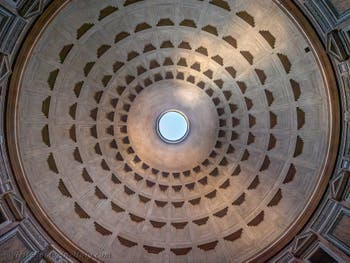
Cupola of the Pantheon The astronomical vocation of the temple confirms the symbolism of the dome of the Pantheon representing the celestial vault.
The Pantheon is indeed oriented on the four cardinal points, and its entrance porch is precisely oriented to the north.
Because of its position, every day at noon, the ray of light that enters through the oculus of its dome projects into the centre of the entrance portal.
The Light from the Oculus
It should also be noted that the oculus of the Pantheon is the only source of light that illuminates the temple's interior.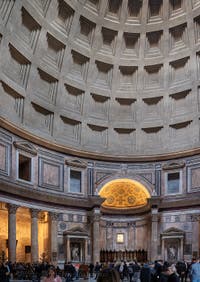
Cupola of the Pantheon The oculus symbolises the Sun around which the planets revolve, as well as the sky god Jupiter who observes us, oculus means eye.
In addition to the daily projection of light from the oculus in the centre of the entrance portal, the orientation of the Pantheon is such that at the equinoxes, as well as at the solstices, the ray of light entering the top of the dome illuminates various precise points on the northern axis of the temple.
On June 21, at the summer solstice, the ray of light from the oculus hits a large porphyry disk located in front of the entrance door to the Pantheon.
To confirm the cosmic and astronomical purpose of the Pantheon, note that the dome’s interior is decorated with five concentric rows, each composed of a series of 28 coffers corresponding to the lunar phases.
Statues of Roman Deities
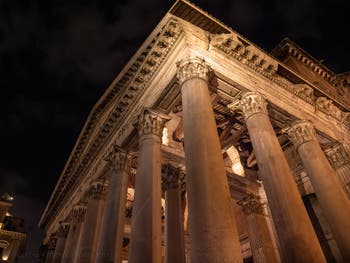
Porch of the Pantheon The Pantheon, a temple of all the gods, housed numerous statues of deities.
We are sure of the presence of three of them: Venus, the goddess of love; Mars, the god of War and Julius Caesar, who was, remember, the first man to be deified by the Romans after his death.
But, likely, Mercury and the Sun, Moon, and Saturn were also represented.
Finally, in addition to its religious connotation, the Pantheon was also used by Emperor Hadrian as a place for meetings and receptions.
So it was a religious meeting room and a political one!
Emperor Hadrian and the architectural design of the Pantheon
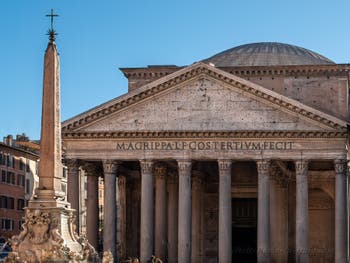
Outside of the Pantheon Buildings topped by a dome were already part of Roman architecture.
The great novelty of the Pantheon came from the combination, in a single building, of a rotunda topped by a cupola connected to a Greek-style porch.
Emperor Hadrian designed the Pantheon to connect a circular temple topped by a dome with a Greek porch.
In addition to his military talents, Hadrian was a poet, painter, sculptor and architect, architecture being his true passion.
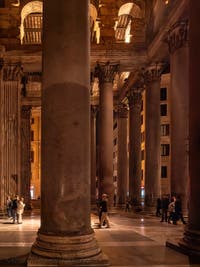
Porch of the Pantheon However, to realise such a magnificent and complex building, the emperor had to assemble a team of architects, master builders, and high-level military engineers to overcome the numerous technical difficulties of such an innovative construction.
Unfortunately, we do not know the names of this team that succeeded in transforming this daring temple project wanted by Hadrian into a construction, still standing and in perfect condition two thousand years later.
We do not know the exact date when construction work on the Pantheon began; it is assumed that it started in the year 118 when Hadrian returned to Rome.
The Pantheon was completed in the year 128, in a record time of barely ten years!
Hadrian: Pleasing the Romans and Magnifying His Glory
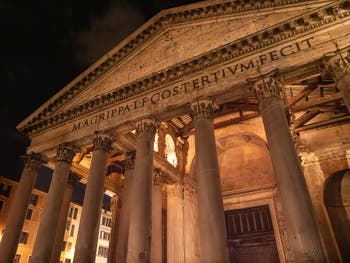
Porch of the Pantheon For Emperor Hadrian, the Pantheon was an excellent way to please the Romans by rebuilding the temple they had frequented assiduously before it burned down while satisfying his architectural passion and desire to build a temple like no other, one whose size beauty and perfection could reflect on his glory.
We imagine the Romans seeing Hadrian sitting under the celestial dome of the Pantheon as the son of a god surrounded by all the gods of Paradise.
Emperor Hadrian wanted to recall the original sacred link with the builder of the first temple by having “M. AGRIPPA L.F. COS. TERTIUM FECIT” engraved on the portico pediment, which means: “Marcus Agrippa, son of Lucius, Consul for the third time, built it in honour of Augustus.”
Next Page: Pantheon's Porch and Rotunda
Art Story Story | Porch Rotunda | Cupola | Basilica | Chapels Tombs
Pantheon Art Story | Location | Opening Hours Tickets | Authorisations
Back to Top of Page

